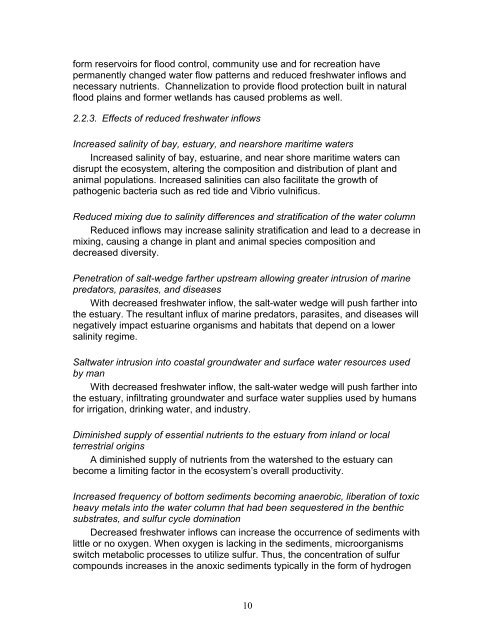The Economic Value of Water and Ecosystem Preservation
The Economic Value of Water and Ecosystem Preservation
The Economic Value of Water and Ecosystem Preservation
You also want an ePaper? Increase the reach of your titles
YUMPU automatically turns print PDFs into web optimized ePapers that Google loves.
form reservoirs for flood control, community use <strong>and</strong> for recreation have<br />
permanently changed water flow patterns <strong>and</strong> reduced freshwater inflows <strong>and</strong><br />
necessary nutrients. Channelization to provide flood protection built in natural<br />
flood plains <strong>and</strong> former wetl<strong>and</strong>s has caused problems as well.<br />
2.2.3. Effects <strong>of</strong> reduced freshwater inflows<br />
Increased salinity <strong>of</strong> bay, estuary, <strong>and</strong> nearshore maritime waters<br />
Increased salinity <strong>of</strong> bay, estuarine, <strong>and</strong> near shore maritime waters can<br />
disrupt the ecosystem, altering the composition <strong>and</strong> distribution <strong>of</strong> plant <strong>and</strong><br />
animal populations. Increased salinities can also facilitate the growth <strong>of</strong><br />
pathogenic bacteria such as red tide <strong>and</strong> Vibrio vulnificus.<br />
Reduced mixing due to salinity differences <strong>and</strong> stratification <strong>of</strong> the water column<br />
Reduced inflows may increase salinity stratification <strong>and</strong> lead to a decrease in<br />
mixing, causing a change in plant <strong>and</strong> animal species composition <strong>and</strong><br />
decreased diversity.<br />
Penetration <strong>of</strong> salt-wedge farther upstream allowing greater intrusion <strong>of</strong> marine<br />
predators, parasites, <strong>and</strong> diseases<br />
With decreased freshwater inflow, the salt-water wedge will push farther into<br />
the estuary. <strong>The</strong> resultant influx <strong>of</strong> marine predators, parasites, <strong>and</strong> diseases will<br />
negatively impact estuarine organisms <strong>and</strong> habitats that depend on a lower<br />
salinity regime.<br />
Saltwater intrusion into coastal groundwater <strong>and</strong> surface water resources used<br />
by man<br />
With decreased freshwater inflow, the salt-water wedge will push farther into<br />
the estuary, infiltrating groundwater <strong>and</strong> surface water supplies used by humans<br />
for irrigation, drinking water, <strong>and</strong> industry.<br />
Diminished supply <strong>of</strong> essential nutrients to the estuary from inl<strong>and</strong> or local<br />
terrestrial origins<br />
A diminished supply <strong>of</strong> nutrients from the watershed to the estuary can<br />
become a limiting factor in the ecosystem’s overall productivity.<br />
Increased frequency <strong>of</strong> bottom sediments becoming anaerobic, liberation <strong>of</strong> toxic<br />
heavy metals into the water column that had been sequestered in the benthic<br />
substrates, <strong>and</strong> sulfur cycle domination<br />
Decreased freshwater inflows can increase the occurrence <strong>of</strong> sediments with<br />
little or no oxygen. When oxygen is lacking in the sediments, microorganisms<br />
switch metabolic processes to utilize sulfur. Thus, the concentration <strong>of</strong> sulfur<br />
compounds increases in the anoxic sediments typically in the form <strong>of</strong> hydrogen<br />
10
















